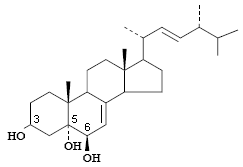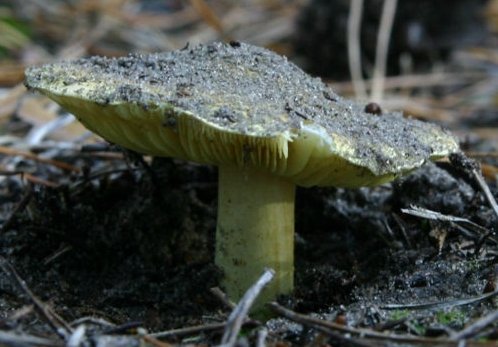Synonyms
Agaricus auratus Paulet
Agaricus equestre L.
Agaricus flavovirens Pers.
Tricholoma auratum (Paulet) Gillet
Tricholoma flavovirens (Pers.) S. Lundell (see Deng and Yao, 2005)
Common name
Man on Horseback
Yellow Knight
Yellow Tricholoma
Canari (French)
Chevalier (French)
Grünling Pilz (German)
Description
Cap: 6-12 cm diameter, convex to plane or with margin elevated, surface viscid when moist, smooth, yellow to greenish-yellow or brownish-yellow, sometimes reddish-brown at the center and yellow towards the margin; may be faintly scaly.
Flesh: thick, firm, white, yellowish before the cap cuticle.
Gills: free, rounded at the stem, sulphur-yellow, close.

Spore print: white.
Spores: 6-8 x 4-5 µm, hyaline, ellipsoid, smooth.
Habitat: Scattered to densely gregarious in grassy or shrubby areas in soil, in coniferous woods, Aug-Oct.
Edibility: See toxicity section.
Anti-osteoporosis
The methanol extract of Tricholoma equestre (referred to as T. aurantum in this paper) contains (22E,24R)-ergosta-7,22- diene-3β,5α,6β-triol (see below), a sterol that stimulates the enzyme alkaline phosphatase (ALP) in mouse bone cells (osteoblasts).

Higher levels of ALP enzyme activity are associated with increased proliferation and differentiation of osteoblasts, and the prevention of osteoporosis (for an example, see Choia et al., 2001). By performing assays with structurally related sterols, the researchers determined that the presence of hydroxyl moieties at carbons 5 and 6 has an important effect on the molecule’s differentiation-inducing activity. Additionally, this compound protected these cells from apoptosis (cell-death) that normally results with serum starvation (Hata et al., 2002).
Antimicrobial activity
Using the disk diffusion and microdilution methods of antimicrobial determination, the chloroform extract of T. equestre was shown to have weak antibiotic activity against Escherichia coli, Staphylococcus aureus and S. epidermidis, and strong activity against Bacillus subtilis. The dichloromethane, acetone and ethanol extracts all showed similar weak activity against S. aureus, S. epidermidis and B. subtilis, while the ethyl acetate extract showed an additional weak activity against Pseudomonas aeruginosa (Yamac and Bilgili, 2006).
Toxicity
Although several guide books claim this species to be choice and edible (for example, see here), reports from France (Anonymous, 2001; Deffieux and Bendry, 2003; Massart, 2003) and Poland (Chodorowski et al., 2002) show evidence of the ‘Man on Horseback’ causing acute rhabdomyolosis (Deffieux and Bedry, 2003), an effect that was later replicated in rats. However, the reported poisoning happened with the consumption of a rather large quantity of mushrooms, and a later study (Nieminen et al., 2005) showed that the same effect was achieved in rats using the commercially popular Boletus edulis. Also confusing is that the Massart paper (2003), refers to the species by a synonym, Tricholoma auratum, and the abstract claims the paper describes “morphological characters that distinguish this species from the closely-related and edible T. equestre“. I’ll update this when I get a hold of the paper. Because the reported poisonings seem to be restricted to Europe, it is possible that a different but morphologically similar species may be the culprit. Another recent study (Niemenin et al., 2008) reports myo-, cardio- and hepatotoxic effects of T. equestre when consumed by mice for long periods of time. Obviously, prudence in deciding edibility should be exercised until further research is done.

My name is Austin Collins.
I've dedicated my life to Mushrooms.
I believe Mushrooms are the best kept secret when it comes to health and well being.
For that reason, I would like to share a company with you that in my opinion makes the best mushroom products on the market.
The company is called Noomadic Herbals, my favorite supplement they make is called "Mushroom Total".
I take their products every day and they have helped me think better and have more energy. Give them a try.
-Austin
Web
See the Health Canada information before consuming this potentially dangerous mushroom.
References
The edibility of Tricholoma equestre in question.
[La Comestibilité du Tricholome équestre en question]
Bulletin de la Fédération Mycologique Dauphiné Savoie. 2001 162:38-9.
Chodorowski Z, Waldman W, Sein Anand J.
Acute poisoning with Tricholoma equestre.
Przegl Lek. 2002 59(4-5):386-7.
Choia EM, Suhb KS, Kimb YS, Chouec RW, Koo SJ.
Soybean ethanol extract increases the function of osteoblastic MC3T3-E1 cells
Phytochemistry. 2001. 56(7):733-9.
Deffieux, G, Bedry, R.
Acute rhabdomyolysis induced by repeated and consecutive ingestion of Tricholoma auratum, the bidaou.
Documents Mycologiques. 2003 32(126):21-9.
Deng, H, Yao, YJ.
Tricholoma equestre, the correct name for T. flavovirens (Agaricales).
Mycotaxon. 2005 94:325-9.
Gluchoff K, Dangycay MP, Arpin N, Pourrat H, Regerat F, Topper E, Steglich W, Deruaz D, Lebreton P.
Chemotaxonomic research on fungi – 7,7′-biphysicon, bianthraquinone obtained from Tricholoma equestre L Per Fr (Basidiomycetes, Agaricales).
Comptes Rendus Hebdomadaires Des Seances De L Academie Des Sciences Serie D. 1972 274(11):1739-&.
Hata K, Sugawara F, Ohisa N, Takahashi S, Hori K.
Stimulative effects of (22E,24R)-ergosta-7,22-diene-3β,5α,6β-triol from fruiting bodies of Tricholoma auratum, on a mouse osteoblastic cell line, MC3T3-E1.
Biol Pharm Bull. 2002 25(8):1040-4.
Karlson-Stiber C, Persson H.
Cytotoxic fungi – an overview.
Toxicon. 2003 42(4):339-49.
Massart F.
The golden tricholoma (Tricholoma auratum [Fr.] Gillet) stands accused.
Documents Mycologiques. 2003 32(126):17-20.
Nieminen P, Mustonen A-M, Kirsi M.
Increased plasma creatine kinase activities triggered by edible wild mushrooms.
Food Chem Toxicol. 2005 43(1):133–8.
Nieminen P, Kärjä V, Mustonen AM.
Indications of hepatic and cardiac toxicity caused by subchronic Tricholoma flavovirens consumption.
Food Chem Toxicol. 2008 46(2):781-6.
Yamac M, Bilgili F.
Antimicrobial activities of fruit bodies and/or mycelial cultures of some mushroom isolates.
Pharmaceutical Biology. 2006 44(9):660-7.



